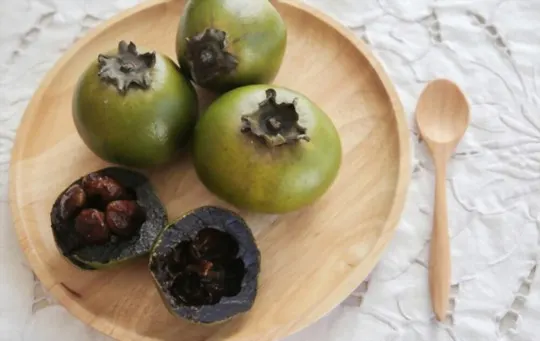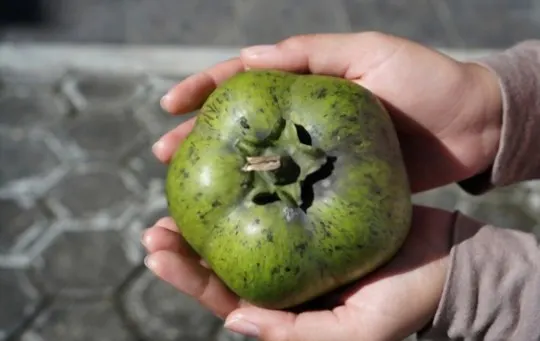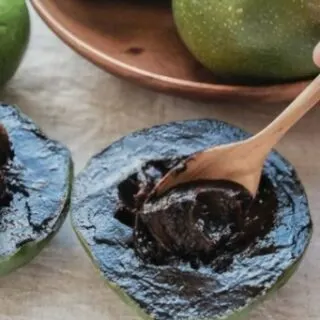Are you curious about sapote but not sure what to expect from its flavor?
Wonder no more because we have the answers!
Sapote is a delightful, tropical fruit that packs a flavorful punch. Its taste can vary depending on whether it’s ripe or unripe, and also by the type of sapote you’re trying—all of which contributes to a wide range of experiences.
In this post, we’ll dive deep into what does sapote taste like, equip you with an understanding of different types and stages of ripeness, as well as provide some delicious recipes that showcase this unique tropical treat.
But first – let’s start at the beginning: why is sapote so special in the world offruit-flavoured delights? Let us explain…
What is Sapote?

Sapote, a fruit native to Central America, may be unfamiliar to many, but it is definitely worth getting to know.
This tropical fruit comes in various colors and has a unique flavor that is often described as a combination of peach, vanilla, banana, and pear.
The texture of the fruit ranges from creamy to grainy, depending on the variety.
Inside the sapote fruit, you will find one to several large seeds that can easily be removed.
In terms of nutrition, sapote is high in fiber, antioxidants, and vitamins A and C.
Moreover, this fruit is believed to have health benefits such as improving digestion, supporting heart health, and aiding in weight loss.
If you have not tried sapote yet, it is worth a shot as it is a delightful and nutritious tropical fruit.
What Does Sapote Taste Like?

Sapote is a tropical fruit native to Mexico and Central America, often referred to as “the chocolate pudding fruit” for its creamy, custard-like texture and sweet flavor that tastes like a combination of pear, banana, and vanilla.
Sapote fruit comes in several varieties, including the commonly found Mamey sapote and Black sapote.
Mamey sapote has a reddish-brown skin and a sweet, earthy flavor that blends caramel, sweet potato, and pumpkin pie.
Black sapote, also known as “the chocolate Sapote,” is a type of persimmon with a dark green skin and a soft, smooth pulp that has a mellow, sweet flavor reminiscent of chocolate pudding.
Sapote is best eaten when fully ripened and can be enjoyed as a dessert or used as an ingredient in smoothies, ice creams, and cakes.
Pro tip: Add a dash of lime juice to sapote dishes to enhance their flavor.
Varieties of Sapote and Their Taste Profiles

Sapote is a tropical fruit that grows across many countries, including Mexico, Central, and South America.
There are several types of sapote, each with its unique taste profile.
Here are the four most common types and their taste profiles:
- Black Sapote: This variety is often called “chocolate pudding” fruit because of its creamy, moist, and chocolate-like texture. It tastes sweet, with notes of vanilla and caramel.
- Mamey Sapote: This sapote has a sweet, creamy, and earthy flavor, similar to pumpkin, with a texture like mashed sweet potatoes.
- White Sapote: White sapote has a delicate, sweet, and mildly tangy flavor, with a texture like custard.
- Canistel Sapote: This sapote tastes like a smooth, sweet potato with a dry and crumbly texture. The flavor is a mix of pumpkin, sweet potato, and egg yolk.
With its unique flavor profile and diverse types, sapote is an excellent fruit choice for those looking to explore new tropical fruit flavors.
1 – White Sapote
White Sapote is a tropical fruit known for its creamy texture and sweet, delicate flavor.
It has a thin green or yellowish skin that encloses the soft and juicy white flesh.
The taste and texture of White Sapote can be compared to a combination of peach, pear, and vanilla custard.
However, its flavor and texture can vary depending on the ripeness of the fruit.
When ripe, White Sapote will be soft to the touch and have a yellowish hue.
It’s best eaten fresh as a snack or dessert, or used as a topping for ice cream, yogurt, or fruit salads.
So next time if you wish to explore tropical fruits, go pick a ripe white Sapote and relish its smooth and buttery texture with a touch of sweetness.
2 – Black Sapote
Black Sapote, also known as chocolate pudding fruit, is a tropical fruit that is native to Central and South America.
It is about the size of a large tomato with a thin, green skin that turns black when ripe.
The fruit’s flesh has a texture similar to chocolate pudding and tastes like a combination of chocolate and banana, with a hint of coffee.
When fully ripe, the flesh of the sapote will be soft and dark brown or black.
It’s delicious eaten fresh, but it can also be used in dessert recipes, such as smoothies, cakes, and ice cream.
Sapotes are a good source of vitamin C, fiber, potassium, and antioxidants.
3 – Mamey Sapote
Mamey Sapote is a tropical fruit that is native to Mexico, Central and South America.
It has a russet-colored skin and a sweet, creamy, orange flesh with a large seed in the center.
The flavor of Mamey Sapote is often compared to a combination of sweet potato and pumpkin, with subtle notes of almond and chocolate.
The texture is creamy and smooth, similar to an avocado but firmer.
Mamey Sapote is usually eaten fresh, as a dessert, or used in milkshakes and smoothies.
It is also used in baking and cooking, adding a unique sweetness and texture to dishes.
4 – Canistel Sapote
Canistel Sapote is a tropical fruit that originated in Mexico but is now grown in various parts of the world.
Describing the taste of sapote can be quite tricky as it has a unique flavor profile that’s hard to compare to any other fruit.
Canistel Sapote has a sweet and creamy flavor similar to a cooked sweet potato or pumpkin.
Its texture is similar to that of a hard-boiled egg yolk, which may take some getting used to.
Some people describe the taste of sapote as slightly musky or earthy, while others find it nutty, like a cross between a banana and an avocado.
Sapote is a nutrient-dense fruit and is a rich source of minerals, vitamins, and antioxidants.
Plus, it’s incredibly versatile and can be eaten by itself or used as an ingredient in smoothies, baked goods, and savory dishes.
Culinary Uses of Sapote

Sapote is a tropical fruit that comes in several varieties, including black sapote and mamey sapote.
The fruit has a unique flavor and texture that lends itself well to a range of culinary applications.
- Black Sapote: Often referred to as the chocolate pudding fruit, black sapote has a delicate, sweet flavor and creamy texture when fully ripe. It makes a delicious addition to smoothies, puddings, ice creams, and baked goods.
- Mamey Sapote: This variety has a sweet and slightly earthy flavor with a creamy, custard-like texture. It’s commonly used in milkshakes, smoothies, sorbets, and ice creams. Mamey sapote also works well in savory dishes and pairs nicely with fish, chicken and pork.
Both types of sapote can be enjoyed fresh, but they also work well as an ingredient in a variety of recipes, adding a unique tropical twist to various dishes.
Pro Tip: When choosing sapote, look for fruit that is firm but not too hard and has no bruising or discoloration.
Store the fruit at room temperature until fully ripe, then keep in the fridge for an extra few days.
Where to Buy Sapote and How to Store It?
Sapote is a tropical fruit that is native to Mexico and Central America.
It has a sweet, creamy, and custard-like flavor with a hint of almond and chocolate undertones.
If you’re looking to buy sapote, you can find it at your local farmer’s market or specialty grocery store during its peak season, which is from October to January.
When choosing sapote, look for ones that feel heavy for their size and have a slightly soft texture.
You can ripen sapote at room temperature for a few days until it gives slightly when squeezed.
Once ripe, you can store sapote in the refrigerator for up to five days.
To enjoy the fruit, cut it in half, remove the seeds, and scoop out the creamy flesh with a spoon.
If you want to get creative, you can also use sapote as a base for smoothies, ice cream, or even pies.
Conclusion
In conclusion, sapote is a tropical fruit that is gaining popularity due to its unique flavor and health benefits.
Its creamy texture, sweet and tangy taste, and versatility in cooking and baking make it a great addition to any diet.
Sapote is loaded with fiber, vitamins, and minerals that can improve your gut health, blood sugar levels, and skin health.
The fruit is harvested when it’s soft, and its thin skin turns brownish.
To enjoy sapote’s rich flavor and texture, slice it in half and scoop out the flesh with a spoon.
You can also add sapote to smoothies, salads, and desserts for a tropical twist.
So why not add this exotic fruit to your grocery list and experience its unique taste yourself?

What Does Sapote Taste Like? A Comprehensive Guide
Ingredients
- Sapote
- Ingredients from your selected recipes
Instructions
- Select ingredients that work well together.
- Use a recipe or method that will enhance their natural taste.
- Taste and adjust the recipe as needed to achieve the desired flavor.

Carrie is a food writer and editor with more than 15 years of experience. She has worked for some of the biggest names in the food industry, including Bon Appétit, Food & Wine, and Martha Stewart Living.
As the Editor in Chief of IntroChicago.com, Carrie oversees all of the content on the site. She also manages the team of contributing writers and editors, who help to create delicious recipes, helpful tips, and informative articles that you’ll find on the site.
A native of the Chicago area, Carrie is passionate about all things food. She loves trying new restaurants and experimenting with new recipes in her kitchen. She’s also a graduate of the Culinary Institute of America, so she knows a thing or two about food!
